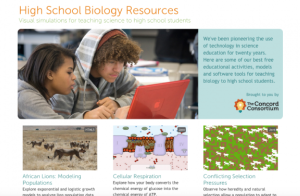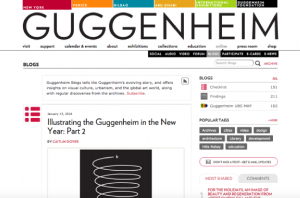Research and Education
Back to Top
|
 |
|
Science & Plants for Schools
|
Science |
|
This website, hosted by Science & Plants for Schools (SAPS), is designed to help teachers "bring plant science alive." While the resources are organized according to the standards of the British school system, educators and enthusiasts the world over will find much to appreciate. Readers may like to scout the site by grade level, including Primary and Secondary. The Students section reveals sections devoted to plant-related Project Ideas, as well as Careers in Biology and Further Study. In addition, the SAPS Image Collection, which can be located under the library tab, provides over 200 freely downloadable photos for use in PowerPoints, worksheets, and posters. Finally, readers may link to the biology videos from the landing page. Here they will find informative videos demonstrating everything from photosynthesis to totipotency. [CNH] |
|





|
|
 |
|
Italian Renaissance Learning Resources
|
Arts |
|
Visually stunning and freely available, this resource from the National Gallery of Art offers readers eight unique units that elucidate the textures, themes, and context of Italian Renaissance artists. Here readers will find thematic essays, more than 300 breathtaking images, 300+ glossary terms, and 42 primary source texts. Readers may like to start by briefly scouting all eight units, which include learning resources on the topics of Virgin and Child, Picturing Family and Friends, The Making of an Artist, A New World in Learning, and others. Each unit features a series of erudite essays, contextualized with related images, glossary terms, discussion questions, and classroom activities. For instance, the Virgin and Child unit begins with an introduction and then offers information about the origins of the iconic relationship, delves into the Power of Icons, and expands into a treatment of Raphael's Madonna's, among other classic works. For educators and art enthusiasts, this site can provide hours of inspiration. [CNH] |
|





|
|
 |
|
American Sociological Association: Facts on Jobs and Careers
|
Social studies |
|
Resources examining the employment outlook for careers in sociology can be a helpful aid for high school and college counselors, engaged parents, educators of all kinds, and students themselves who are considering career paths in the social sciences. Produced by the American Sociological Association (ASA), the information provided here is divided broadly into four categories: PhD Careers, Jobs and Careers for Sociology Majors and Baccalaureates, Masters Graduates and the Job Market, and Faculty Careers. Each category boasts about a dozen resources, all of which link to ASA survey results (trend data) or are freely downloadable in PDF or Powerpoint formats. Readers may be especially interested in the link to the American Sociological Association's trend data on Labor Force Participation Rates for Doctorate Social and Behavioral Scientists, which shows a significant downward shift in labor engagement for PhD graduates in a range of social science disciplines. Other resources, such as the PowerPoint entitled "The Future of Sociology: Minorities, Programs, and Jobs" can offer important information for future predictions. Those who are contemplating a career in any of the social sciences may find valuable information on this American Sociological Association website. [CNH] |
|





|
|
 |
|
 |
|
Edutopia: Education Video Library
|
Educational Technology |
|
These videos from Edutopia, the dissemination arm of the George Lucas Foundation, serve as useful resources for teacher education faculty, graduate students in teacher education programs, and anyone else interested in learning more about PK-12 education today. Brief and interesting, they showcase the kinds of evidence-based learning strategies taking place in classrooms across the country. For instance, "Performance-Based Assessment: Making Math Relevant" features role-playing students at a Pennsylvania high school, suggesting an engaging way for students to assess their own skills using a performance-based simulation. Each video focuses on a particular school and a sidebar offers contextualizing demographics on the district, such as per pupil expenditures, racial makeup of the student body, and percentage of students receiving free lunch. [CNH] |
|





|
|
 |
|
Space Science Institute
|
Science |
|
The Space Science Institute has built a website geared toward the constructivist learning approach, which posits that learning entails an active and fluid construction of knowledge. Here readers will find downloadable lessons that emphasize student participation and problem solving. Resources include an experiential guide to kinesthetic astronomy, an excellent Saturn Educator Guide, and other astronomy-related resources. To participate in the lesson plans and activities, readers may simply navigate to the topic of their choice and then download the files they find most helpful. For example, Solarscapes, which "presents middle school students with a short, focused study of the physical nature of the Sun," includes a brief introduction, four activities, several figures, and a helpful answer key. Educators looking for reliable space-related resources will find much to appreciate on the Space Science Institute's website.[CNH] |
|





|
|
 |
|
 |
|
Constitutional Rights Foundation
|
Social studies |
|
The Constitutional Rights Foundation (CRF), a non-profit, non-partisan organization based in Los Angeles, seeks to educate young people about the United States Constitution, the Bill of Rights, and the benefits of civic participation. On the site, educators will find many Common Core ready resources. Readers may like to start with the Teachers tab, which navigates to the Teacher's Lounge. Here, lessons abound on such topics as the Syrian Refugee crisis, the foundations of Enlightenment philosophy, and the Federalist Papers. The CRF Blog, which boasts several dozen categories, from Africa to Intellectual Property to Urban Issues, is another strength of the site and links to related blogs and resources around the web. Of course, the aptly titled Free Lessons tab harbors many civics-related lessons drawn from various CRF publications, including U.S. Gun Policies and the Declaration of Independence, among others. [CNH] |
|





|
|
























